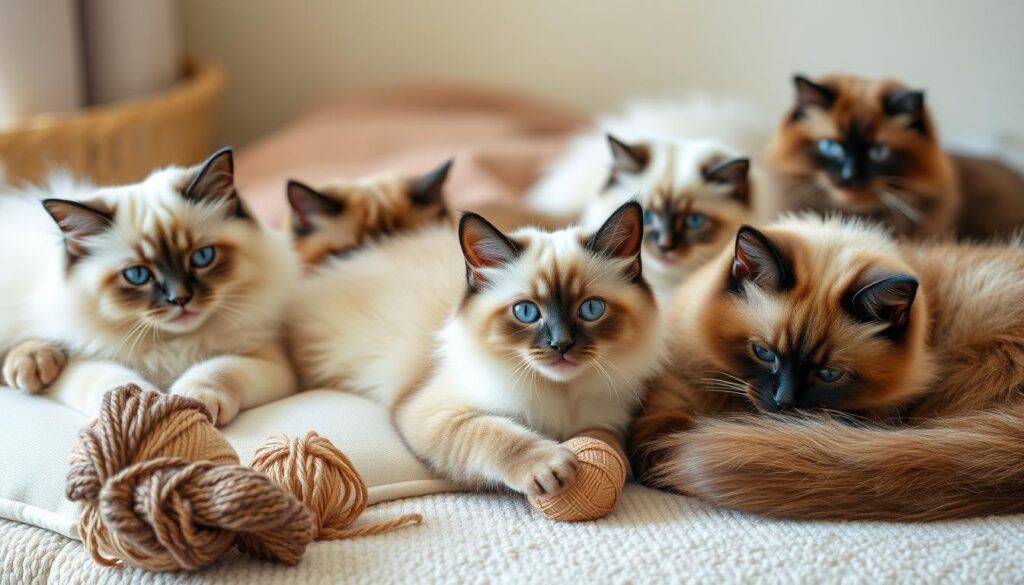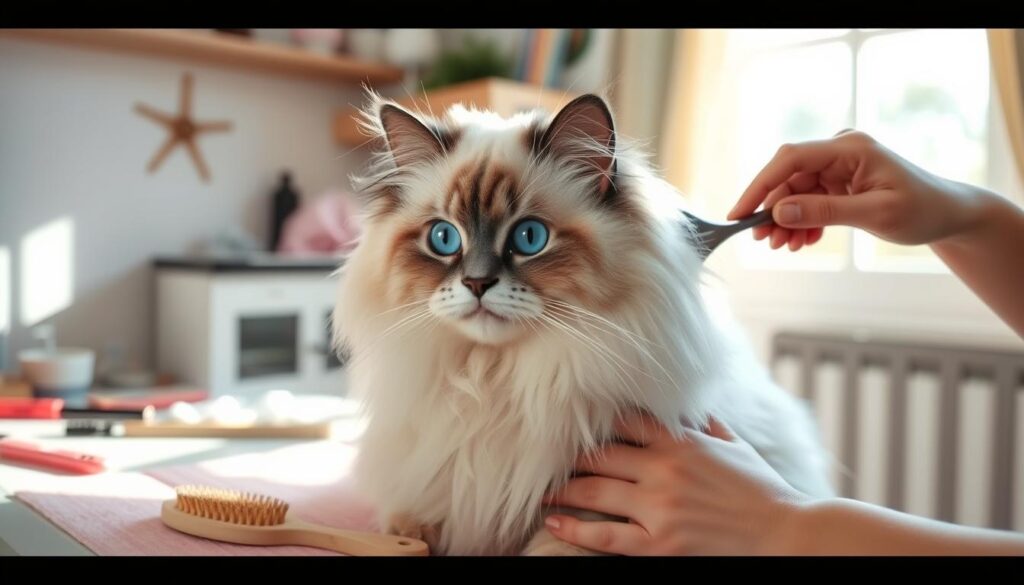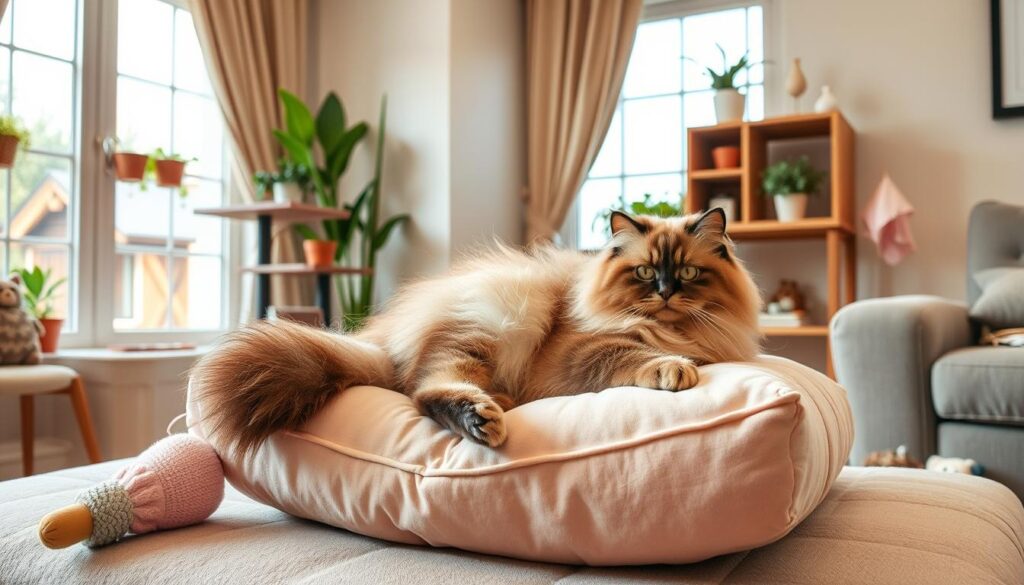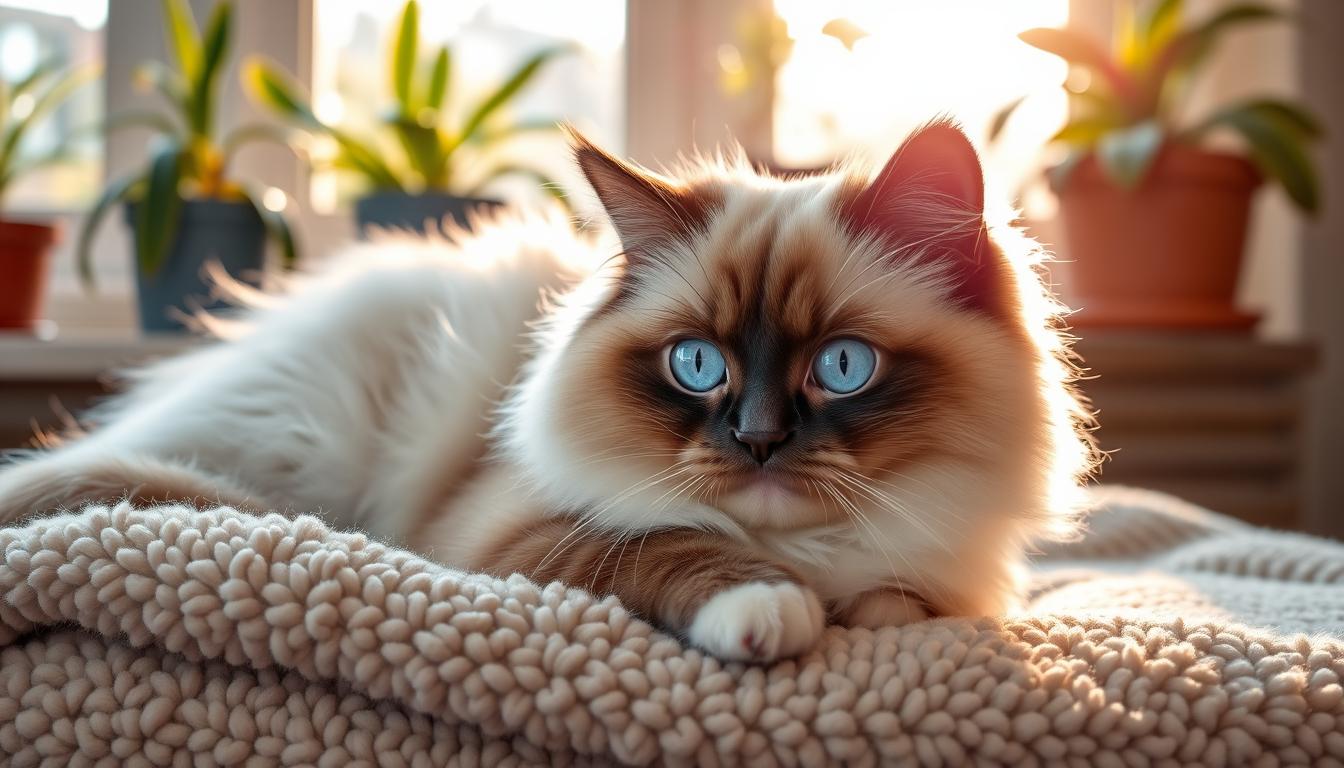The Ragdoll cat breed has become very popular in recent years. They are known for being very affectionate and gentle. This makes them a great choice for many families in the United States.
If you’re thinking about getting a Ragdoll cat, it’s important to know how to care for them. This guide will help you understand what it takes to care for a Ragdoll cat. Whether you’re looking for Ragdoll Cats for Sale or reputable Ragdoll Cat Breeders, we’ve got you covered.
We’ll cover everything from their history and personality to grooming and health needs. With the right care, your Ragdoll cat can thrive and become a beloved family member. If you’re considering buying from Ragdoll Cat Breeders or adopting a Ragdoll cat, this guide will help you make the right choice. It will also give you the knowledge to ensure your new pet has the best life possible.
Key Takeaways
- Understanding the Ragdoll cat breed and their unique characteristics is crucial for proper care.
- Ragdoll cats require regular grooming to maintain their coat and overall health.
- A balanced diet and regular exercise are essential for a Ragdoll cat’s well-being.
- Ragdoll cats are known for their affectionate nature and make great companions for families.
- Researching reputable Ragdoll Cat Breeders is vital when looking for a new pet.
- Ragdoll cats have specific health needs that require regular veterinary check-ups.
The Fascinating History of Ragdoll Cats
The Ragdoll cat breed has a rich history that started in 1960s California. Breeders aimed to create a cat with a special look and personality. The Ragdoll Cat History shows the hard work and love of these breeders.
Today, Ragdoll Cat Breeders are key in keeping the breed alive. They make sure the breed standard is followed. They also focus on the health and happiness of these lovely cats. Knowing the Ragdoll’s history helps us value the work of these breeders.
Origins in 1960s California
Ann Baker, a California breeder, started the Ragdoll breed in the 1960s. She found a cat named Josephine, who was very soft and went limp when picked up. Her unique traits made her perfect for breeding.
Development of the Breed Standard
The Ragdoll breed standard has changed a lot over time. Breeders have worked to improve the breed’s look, size, and coat. Today, groups like the International Cat Association help keep the standard.
Some key traits of Ragdolls include:
- A soft, silky coat in many colors and patterns
- A big, strong body with a broad chest and sturdy legs
- A short, rounded tail and a wedge-shaped head
- A friendly, loving nature, making them great pets
Distinctive Features of the Ragdoll Cat Breed
The Ragdoll cat breed is famous for its Ragdoll Cat Colors. These can be solid, mink, sepia, or pointed. Their soft, silky coats add to their appeal, making them a favorite among cat lovers.
Ragdolls are also known for their Ragdoll Cat Personality. They are affectionate, gentle, and laid-back. They bond strongly with their owners, often acting like puppies. They love to follow their owners and enjoy being cuddled.
Some key traits of Ragdolls include:
- A muscular, medium-sized body with a broad chest and strong legs
- A short, soft coat that requires minimal grooming
- A docile, easy-going temperament that makes them a great choice for families with children
The Ragdoll cat breed is a cherished companion. They are known for their stunning looks and loving nature. Whether you’re new to cats or have had them before, a Ragdoll is a wonderful choice for a loyal friend.
Understanding Ragdoll Cat Colors and Patterns
Ragdoll cat colors are a big part of their charm. They come in many point colors and patterns. As Ragdoll kittens grow, their colors and patterns can change. It’s important to know about the different stages of their coat development.
The Ragdoll breed is famous for its striking point colors. These can be solid, mink, or sepia. Point color variations happen because of two melanins: eumelanin and pheomelanin. This mix creates colors like seal, blue, chocolate, and lilac.
Point Color Variations
- Seal: a deep, rich brown color
- Blue: a pale, silvery gray color
- Chocolate: a warm, golden brown color
- Lilac: a pale, pinkish-gray color

Pattern Types
Ragdoll cats have many pattern types, like solid, mink, sepia, and pointed. These patterns can mix with different point colors. This creates a unique and stunning look. For instance, a kitten with seal point and mink pattern is truly special.
The Gentle Giant: Ragdoll Cat Personality Traits
Ragdoll cats are known for their gentle and affectionate nature. They make great companions for many families. Their calm and laid-back nature is perfect for those who want a pet that’s easy to care for.
To care for a Ragdoll cat, it’s important to know their emotional and social needs. They need regular interaction and playtime.
Some key aspects of Ragdoll Cat Personality include:
- Affectionate and loving nature
- Intelligence and playfulness
- Calm and laid-back demeanor
For more information on Ragdoll cats, visit Ragdoll cat breed information. There, you can learn about their history, characteristics, and care needs. Understanding their personality and needs helps create a happy home for your Ragdoll cat.
Ragdoll cats are perfect for those seeking a gentle and loving pet. Their easy-going nature and low-maintenance care make them a great choice for many families.
Essential Care Requirements for Ragdolls
Ragdoll cats need regular care to stay healthy and happy. Proper Ragdoll Cat Care includes daily routines, exercise, and mental stimulation. This care helps your Ragdoll cat thrive and prevents health issues.
Daily Care Routine
A daily routine for Ragdolls includes feeding, grooming, and playtime. It’s important to have a consistent routine. This makes your cat feel secure and comfortable. Key daily care aspects include:
- Feeding a balanced diet
- Providing fresh water
- Cleaning the litter box
- Spending quality time with your cat
Exercise Needs
Ragdolls need regular exercise to stay healthy and active. Playing with your cat, using toys, and providing scratching posts are great ways to encourage exercise. Regular exercise helps prevent obesity and other health issues, which is key for Ragdoll Cat Health.
Mental Stimulation
Mental stimulation is vital for Ragdolls. It helps prevent boredom and stress. You can provide mental stimulation with puzzle toys, interactive games, and scratching posts. Keeping your cat’s mind active ensures they stay happy and healthy, which is crucial for overall Ragdoll Cat Care and Ragdoll Cat Health.
Grooming Your Ragdoll’s Luxurious Coat
Grooming your Ragdoll cat is key to keeping their coat healthy and looking great. The coat colors vary, but all need regular grooming to avoid mats and tangles. Brushing daily can cut down on shedding and stop hairballs.
There are important tasks in Ragdoll cat grooming. These include:
- Brushing: Use a gentle brush or comb to remove loose hair and distribute skin oils.
- Nail care: Trim your Ragdoll’s nails regularly to prevent overgrowth.
- Ear cleaning: Gently clean the ears with a cotton ball or soft cloth.
Regular grooming also helps you bond with your Ragdoll. It lets you spot health issues early. By making grooming a part of your daily routine, you keep your cat’s coat clean and healthy. This also strengthens your bond with them. 
Remember, grooming needs vary based on your Ragdoll’s coat. Some colors may mat or tangle more easily. So, use gentle tools and techniques to avoid damage. By following these tips and sticking to regular grooming, you can keep your Ragdoll’s coat in top shape.
Nutrition Guidelines for Healthy Ragdolls
Proper nutrition is key for your Ragdoll’s health and happiness. A balanced diet can prevent many health issues. It’s worth the investment to keep your Ragdoll healthy and happy.
A Ragdoll’s nutritional needs change with age.
Kitten Feeding Schedule
Kittens grow fast and need to eat often. Feed your Ragdoll kitten 3-4 times a day until they’re six months old.
Adult Diet Requirements
Adult Ragdolls do well on high-quality cat food. Choose a food rich in protein and low in carbs.
Senior Cat Dietary Needs
Senior Ragdolls may need a diet that’s lower in calories. This helps prevent weight gain and health issues. Talk to your vet to find the right diet for your senior Ragdoll.
Give your Ragdoll a nutritious diet to ensure a long, healthy life. Always check with your vet before changing their diet.
Common Health Considerations for Ragdoll Cats
Keeping your Ragdoll cat healthy is crucial. It’s important to know about genetic health issues that can affect them. Responsible Ragdoll Cat Breeders help ensure their cats are healthy. They follow practices that reduce the risk of inherited diseases.
Ragdolls can face health problems like hypertrophic cardiomyopathy and hip dysplasia. These issues can lead to heart failure and arthritis. Early detection through health screenings is key. Preventive care can also help manage these conditions.
To keep your Ragdoll healthy, choose reputable breeders who focus on health. Owners can also prevent health issues. This includes keeping your cat at a healthy weight, exercising them regularly, and staying on top of vet visits. Being proactive helps your Ragdoll live a long, happy life.
Some important health tips for Ragdolls include:
- Regular veterinary check-ups
- Genetic health testing
- Preventive care, such as vaccinations and parasite control
- A healthy diet and lifestyle
By focusing on Ragdoll cat health and choosing responsible breeders, owners can ensure their cats thrive. This way, Ragdoll owners can enjoy the many joys of having these wonderful pets.
Creating the Perfect Indoor Environment
Creating a cozy and fun indoor space is key for Ragdoll Cat Care. It’s important to design a cat-friendly area. This area should fit the Ragdoll’s big size and loving nature.
The color of your Ragdoll can also affect your space’s look. For instance, a bright room can make their coat colors pop.
Here are some tips to make a great indoor space:
- Make sure there’s enough room for your Ragdoll to climb and scratch. Use cat trees or shelves.
- Choose furniture and decor that’s strong and easy to clean. Ragdolls can be messy and shed a lot.
- Use scratching posts and pads to keep your Ragdoll’s nails healthy and protect your furniture.
By following these tips, you can make a space that’s both comfy and fun. It will meet your Ragdoll’s physical and emotional needs.

Socializing Your Ragdoll with Family Members
Socialization is key in Ragdoll Cat Care. It makes your cat confident and calm around family. A well-socialized Ragdoll cat is vital for a peaceful home. This starts with introducing your cat to kids and other pets.
Introduction to Children
When introducing your Ragdoll cat to kids, watch them closely. Teach kids to handle your cat gently and with respect. Encourage them to move slowly and calmly around the cat.
Multi-Pet Households
In homes with many pets, socialization is crucial to avoid fights. Introduce your Ragdoll cat to other pets slowly. Let them get used to each other’s scents and sounds. With patience and proper Ragdoll Cat Care, you can make a peaceful home for all pets.
- Start with slow introductions, allowing pets to become familiar with each other’s presence.
- Supervise interactions between pets, intervening if necessary to prevent conflicts.
- Reward calm behavior with treats and praise, encouraging a peaceful coexistence.
By socializing your Ragdoll cat with family, you help it develop a strong Ragdoll Cat Personality. This makes your home happy and harmonious.
Training Tips and Techniques
Training is key in Ragdoll Cat Care. It ensures your cat’s well-being and behavior. Positive reinforcement works well for Ragdolls. It encourages good behavior and strengthens the bond between cat and owner.
To start training, pick specific behaviors to focus on. This could be litter box training or using a scratching post. Create a routine with positive reinforcement like treats and praise. Regular sessions will make your Ragdoll a loving and well-behaved companion.
Here are some important training tips for your Ragdoll:
- Be patient and consistent in your training approach
- Use positive reinforcement techniques to encourage good behavior
- Keep training sessions short and fun to avoid overwhelming your cat
Investing time in Ragdoll Cat Health and training is crucial. It helps your cat live a happy and healthy life. Always consider your cat’s needs and personality when training.
What to Consider Before Getting a Ragdoll
Before getting a Ragdoll cat, think about the Ragdoll Cat Price and the care time needed. Ragdolls are loving and calm, perfect for many families.
Cost is a big factor when buying a Ragdoll from Ragdoll Cat Breeders. Prices change based on location, bloodline, and age. You’ll also need to budget for food, litter, and vet bills.
Time is another key thing to think about. Ragdolls need regular grooming and play to stay happy. If you’re busy, you might need a pet sitter or a friend to check on your cat.
Before getting a Ragdoll, consider these points:
- Space: Ragdolls need room to move and play, so check if your home is big enough.
- Time: They need grooming and playtime, so make sure you have enough time for them.
- Cost: The cost of a Ragdoll and their care can be high, so plan your budget.
Finding Reputable Ragdoll Cat Breeders
When looking for Ragdoll Cat Breeders, it’s key to find someone who cares about their cats’ health. A reputable breeder will give you a kitten that’s both healthy and well-socialized. This kitten will be a great friend. Look for breeders who are part of recognized cat associations, like the International Cat Association or the Cat Fanciers’ Association.
Here are some tips to find a reputable breeder:
- Research the breeder’s reputation online and ask for references from other cat owners.
- Visit the breeder’s facility in person to see the conditions and meet the cats.
- Ask about the breeder’s health guarantee and contract.
- Make sure the breeder provides you with all the necessary paperwork, including registration and vaccination records.
If you’re searching for Ragdoll Cats for Sale, choose a reputable breeder. They will give you a healthy, well-socialized kitten. Stay away from pet stores and online sellers who might be from irresponsible breeders. By researching and finding a reputable breeder, you’ll get a wonderful companion that will bring joy and love into your life.
Essential Supplies for Your New Ragdoll
When it comes to Ragdoll Cat Care, having the right supplies is key. You’ll need food, litter, and grooming tools. Choose a high-quality cat food that fits your Ragdoll’s needs. There are many types of litter, like clay, silica, and recycled paper.
For Ragdoll Cat Grooming, you’ll need a few basic tools. A brush keeps their coat clean and healthy. Nail clippers prevent overgrowth. Shampoo is needed for occasional baths.
Here are some essential supplies to consider:
- Food and water bowls
- Litter box and litter
- Brush and other grooming tools
- Scratching post
- Toys and scratching pads
Choose supplies that are durable and easy to clean. With the right supplies, you’ll be well on your way to providing your Ragdoll with the care they need to thrive.
Why Ragdolls Make Extraordinary Companions
Ragdoll cats are truly special pets. They are known for their gentle and loving nature. They also adapt well to different homes.
These cats have a calm and friendly personality. They love to be close to their human family. This makes them one of the most loving cat breeds.
Ragdolls are easy to care for and get along well with kids and other pets. They enjoy spending time with their owners. They love to cuddle and sit on laps for hours.
If you want a loving and adaptable pet, a Ragdoll is a great choice. They are beautiful, friendly, and easy to get along with. It’s no surprise that Ragdoll cats are loved by many around the world.
FAQ
What is a Ragdoll cat?
Ragdoll cats are a type of domestic cat. They are big, have a soft coat, and are very affectionate. They love to cuddle and relax with their owners.
What are the origins of the Ragdoll cat breed?
In the 1960s, a woman named Ann Baker started the Ragdoll breed in California. She chose a Persian-Angora mix for its calm and trusting nature.
What are the distinctive features of Ragdoll cats?
Ragdolls are big, with a soft coat and a special color pattern. They have big blue eyes and a friendly personality.
What are the different color variations of Ragdoll cats?
Ragdolls come in many colors like seal, blue, chocolate, and lilac. They also have different patterns like bicolor, mitted, and van.
What is the personality of a Ragdoll cat?
Ragdolls are very gentle and loving. They are like dogs, loyal and social, and love to be around people.
What are the grooming needs of a Ragdoll cat?
Ragdolls need regular grooming to keep their coat looking good. They should be brushed 1-2 times a week and their nails trimmed often.
What are the health considerations for Ragdoll cats?
Ragdolls are mostly healthy but can get certain diseases like HCM and PKD. Regular vet visits are key to their health.
How much do Ragdoll cats cost?
Ragdoll prices vary based on the breeder, location, and the cat’s traits. Kittens can cost between 0 and ,000 or more.
How do I find a reputable Ragdoll cat breeder?
Look for breeders who are part of cat associations like TICA or RFCI. A good breeder cares about their cats’ health and prepares buyers to care for them.
What are the essential supplies I’ll need for a Ragdoll cat?
You’ll need good cat food, litter, scratching posts, toys, grooming tools, and a comfy bed. Also, find a vet who knows about Ragdolls.

